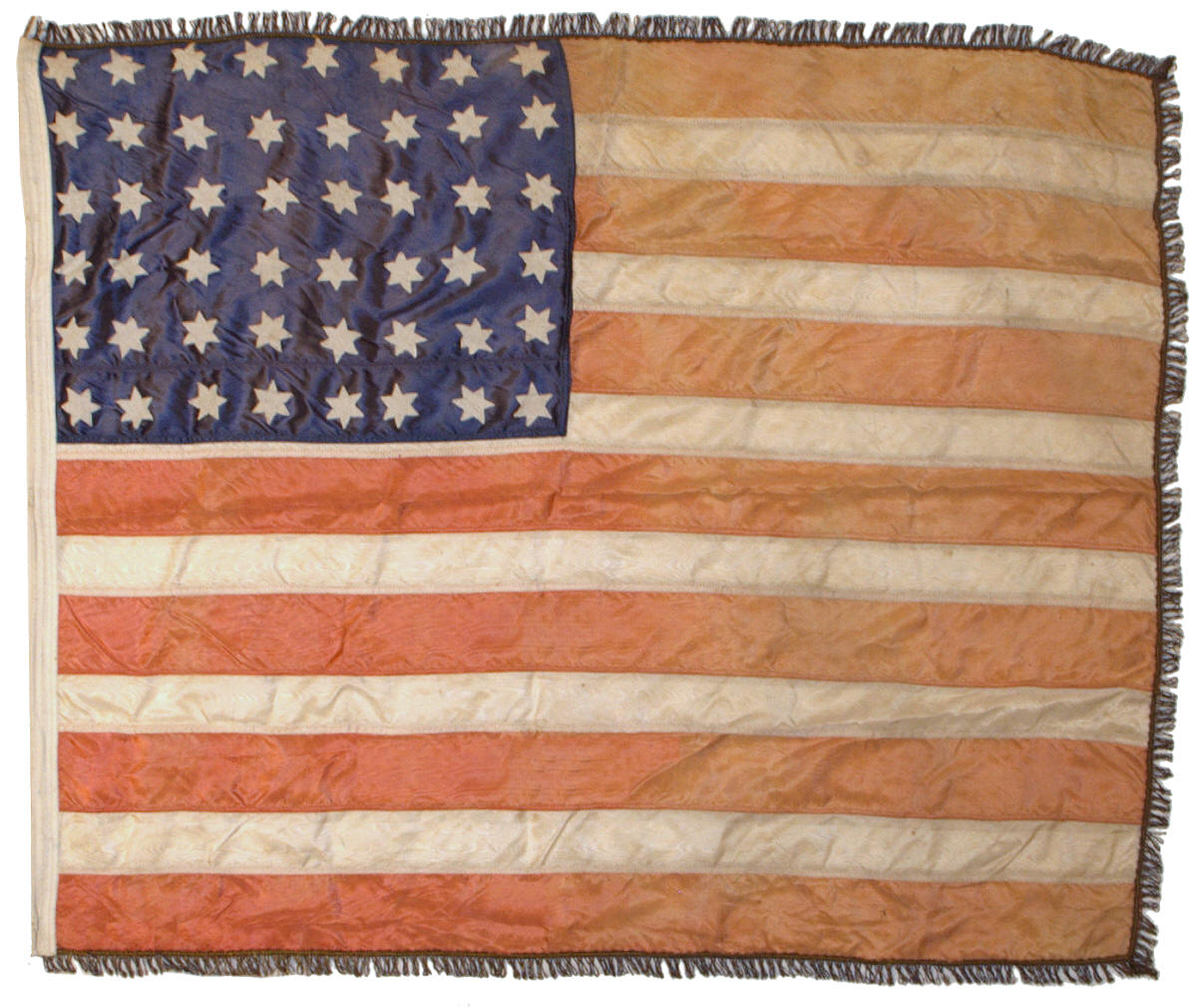 Liberation
flags, such as this beautiful French-made flag from the
Pont-Aven, Bretagne, France, are a fascinating subset of
early American flags. The history of this flag is
that it was
inspired by the liberation of Pont-l'Abbe in Normandy,
just days after the D-Day invasion.
They often feature some of the most whimsical and
unusual design elements seen on early American flags,
such as unusual star counts, unusual numbers of stripes,
unusual dimensions, and other qualities that are
evidence that they were made by people who knew how the
American flag generally looked, but may not have known
all of the exact details of our flag. This
wonderful example is very well made, and features some
beautiful elements that are not usually found on these
types of flags. The 48 stars are six-pointed,
which is a very rare trait on any early American flags.
Whether the choice of using six-pointed star, with its
association as the Star of David and the plight of the
Jews in Europe during World War II, is intentional or
not, its effect is nevertheless a poignant reminder of
such a wrenching human tragedy. The border of the
flag is made of a wiry metallic bullion fringe, which
may have been repurposed from some upholstery or
curtains. The sleeve hoist still holds the flag's
original rope. The blue canton is made of a fine
silk, and the red and white stripes are made of a nylon
or rayon fabric. The canton is inset into the
third white stripe, and nearly sits on the red "blood
stripe", which is another rare trait on early American
flags. Overall, it is a fantastic example of the
type, and a symbol of the sacrifices made by American
soldiers during their heroic liberation of Europe, and
of the deep appreciation felt by the people they
liberated. Liberation
flags, such as this beautiful French-made flag from the
Pont-Aven, Bretagne, France, are a fascinating subset of
early American flags. The history of this flag is
that it was
inspired by the liberation of Pont-l'Abbe in Normandy,
just days after the D-Day invasion.
They often feature some of the most whimsical and
unusual design elements seen on early American flags,
such as unusual star counts, unusual numbers of stripes,
unusual dimensions, and other qualities that are
evidence that they were made by people who knew how the
American flag generally looked, but may not have known
all of the exact details of our flag. This
wonderful example is very well made, and features some
beautiful elements that are not usually found on these
types of flags. The 48 stars are six-pointed,
which is a very rare trait on any early American flags.
Whether the choice of using six-pointed star, with its
association as the Star of David and the plight of the
Jews in Europe during World War II, is intentional or
not, its effect is nevertheless a poignant reminder of
such a wrenching human tragedy. The border of the
flag is made of a wiry metallic bullion fringe, which
may have been repurposed from some upholstery or
curtains. The sleeve hoist still holds the flag's
original rope. The blue canton is made of a fine
silk, and the red and white stripes are made of a nylon
or rayon fabric. The canton is inset into the
third white stripe, and nearly sits on the red "blood
stripe", which is another rare trait on early American
flags. Overall, it is a fantastic example of the
type, and a symbol of the sacrifices made by American
soldiers during their heroic liberation of Europe, and
of the deep appreciation felt by the people they
liberated.The
following is a brief history of the liberation of Pont-l'Abbe,
in Normandy, which occurred in early June, 1944, just
days after the Normandy Invasion.
| |
"On D plus
1 the three regiments of the 90th Infantry
Division were assembled west of the river
Merderet in the Cotentin. General Mac Kelvie's
troops relieved the 82nd Airborne Division. On
10 June the Americans launched the attack toward
the west and liberated Picauville; but in front
of Pont-l’Abbé the 358th Infantry Regiment was
kept in check facing a stiff resistance of the
Germans. The 90th Infantry Division who lacked
combat experience suffered heavy losses. On 12
June the Americans stormed Pont-l’Abbé under
artillery shelling and air bombing. In the night
of 12 to 13 June the Germans évacuated the town,
and American infantry entered a ruined and
silent city. General Mac Kelvie was relieved of
his command, and General Landrum took the lead
of the 90th Infantry Division. The 82nd Airborne
Division was again on the way to the front." |
|
| |
-
Normandy 1944 |
|
|

